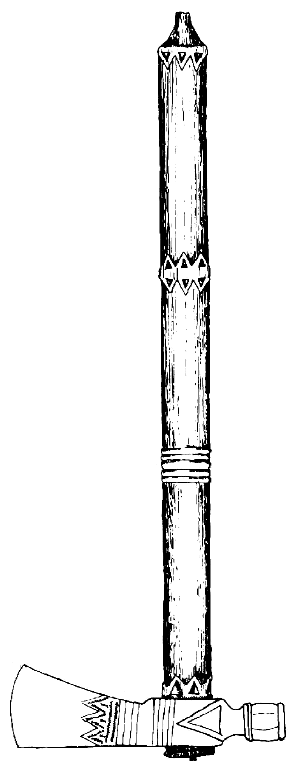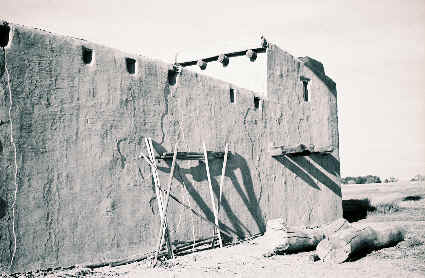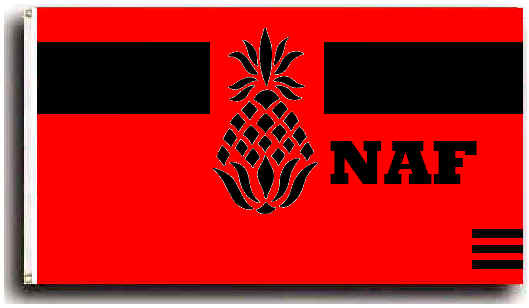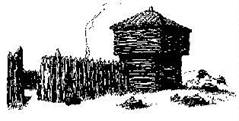|
Spelling is used as it was in
the references, so you get the full effect.
As we start on a very different
kind of article, let me say that the reason of this one is not to
express one point of view over another. But, to have in your hands,
various descriptions of a group of people in which we see a wide range
of equipment, styles and looks. Hopefully, these words, with the places
they are found (some which are in the first person, the best and most
accurate type of reference to use) will be a help for you to improve
your own accoutrements or be a back up to what you might already have.
"The Shawnees of the
party wore buckskin pants and hunting shirt, with fringes of buckskin
strings along the seams of the legs and sleeves..... Most of the white
trappers wore a dress similar to that of the Shawnees, an account of
its great durability, as it would last from three to four years, not
with standing the hard use it received." pg. 19 "Wild
Life in the Far West" by James Hobbs (Rio Grande Press)
"I supped this minute at
a tavern table, amidst village politicians, pedantic doctors, and wise
looking lawyers- My dirty hunting shirt and greasy leather breeches
seemed to offend their hypercritical eyes and too curious olfactories-
God Help them!." "The Rocky Mountain Journals of William
Marshall Anderson", pg. 54
"Here I am, a regular
carter of Fort William, dressed in cowskin (buffulo) pants, cowskin
coat, buckskin shirt, wolfskin cap, red flannel undershirt, and a blue
check shirt over that..""Forty Years a Fur Trader on the
Upper Missouri" (the personal narrative of Charles Larpentuer)
pgs. 43-44.
"...Naturally, if some
of this mixture (speaking of castorium) spilled on their hands, they
wiped it on their buckskins; they didn't stop there, but wiped their
greasy hands on their skins after eating, and wiped off the blood when
skinning. The resulting color and flavor of the skin was not the clean
gold of fresh-tanned hides, but, as Berry says....black. Dirty black,
greasy black, shiny black, bloody black, stinky black. Black.""Journal
of a Mountain Man" by James Clyman pg. 7
"His dress was the usual
hunting-flock of buckskin, with long fringes down the seams, with
pantaloons similarly ornamented, and moccasins of indian make."
pg. 4 (Journal of a Trapper)
"..his personal dress is
a flannel or cotton shirt (if he is fortunate enough to obtain one, if
not antelope skin answers the purpose of over and under shirt) a pair
of leather breeches with blanket or smoked buffulo skin, leggings, a
coat made of blanket or buffulo robe, a hat or cap of wool, buffulo or
otter skin his hose are pieces of blanket lapped round his feet which
are covered with a pair of moccasins made of dressed deer elk or
buffalo skins with this long hair falling loosely over his shoulders
completes his uniform." pg. 82, "Journal of a Trapper"
Osbourne Russell.
"The upper part of the
body was clad in a light blue shirt of course cotton or other cloth,
and in some cases breeches with long deerskin leggings were worn,
leaving the thighs and hips bare. The cloth which was folded around
the loins was held in place by the girdle, while a "hunting shirt
with a large cape and loose sleeves reached nearly to the knees."
pgs. 60 and 61 "The American Fur Trade of the Far West"
by Hiram Martin Chittenden Volume one.
"The costume of the
trapper is a hunting shirt of dressed deerskin, ornamented with long
fringes, pantaloons of the same material, decorated with porcupine
quills and long fringes on the outside of the leg. A flexible felt hat
and moccasins clothe the extremities" pg. 228 "Ruxton of the
Rockies" by George Ruxton.
"The cloth pants were
gone too- ripped- and long since replaced with buckskin. Buckskin wore
for ever, eventually getting black and hard with grease, and you
didn't have to pay a price jacked way up because someone had brought
your pants by horse back from St. Louis. The fringes came in handy,
too for various repairs." pg. 44 "Give Your Heart to the
Hawks" by Winfred Blevins.
"I was still wearing my
city clothes, and mountain men present asked Williams what he was
going to do with that city lad in the mountains. This remark cut me
deeply, and I hurried to the frontier store and traded all my fine
clothes, shirts and dickies, which were worn in those days, for two
suits of the finest buckskin, such as these merchants always kept on
hand to fleece greenhorns like myself, making five hundred percent
profit in the trade. The next morning I appeared dressed "a la
prairie" and the old trappers noticed the change and said
"Williams, that boy of yours will make a mountaineer if he
catches on at this rate." pgs. 18,19 "My Sixty years on
the Plains" by William Thomas Hamilton.
Much of this had to do with
tailoring. We have seen that the mountain man preferred wool clothing
when he could get it, but probably he had little that was still
serviceable when winter came.If he had worn skin breeches, he had staged
them at the knees and sewn on legs of blanketing which would not shrink
intolerably when they dried......For moccasins and the leggings which
both Indians and trappers wore, usually to the hip, the best material
was last year's tipi." pg 163. Bernard De Voto- "Across the
Wide Missouri".
Gerald Rawling, writer of
"The Pathfinders": "The rest of his equipment he wore on
his body. His clothes were of cotton or wool when he could get them, but
store bought clothes seldom lasted the season though, and more often
than not he had to make do with animal hides. He wore a fringed buckskin
hunting shirt with a pair of leather breeches and leggings made of
smoked buffulo hide. His feet were wrapped in strips of blanketing, and
encased in moccasins of indian manufacture- the only possible footwear
for getting about in rough country. Over all, he wore a capote (blanket
coat) or a buffulo robe pulled in at the waist by a leather belt, into
which were thrust a piratical collection of sidearms- pistols,scalping
knifes and hatchets- while suspended from his shoulder was a powder horn
and bullet pouch." pgs 52 and 53.
"Down to his shoulders
hung the hunter's hair, covered with a felt hat or perhaps the hood of
a capote. He liked wool clothing, for it would not shrink as it dried
and wake him, when he dozed beside the fire, by agonizingly squeezing
his limbs. But wool soon wore out and he then clad himself in leather,
burdensomely heavy to wear, fringed on the seams with the familiar
thongs which were partly to decorate but most utilitarian, to let rain
drip off the garment rather than soak in, and to furnish material for
mending. Further waterproofing was added by wiping butcher and eating
knifes on the garments until they were black and shiny with grease.
Upper garments might be pull-over type or cut like a coat, the
buttonless edges folded over and clinched into place with a belt. No
underclothes were worn, just breechclout. In extreme cold a Hudson's
Bay blanket or a buffulo robe was draped Indian-wise over the entire
costume." Bent's Fort By David Lavender pgs.73-74.
"..the old trappers and
hunters wear their hair flowing on their shoulders, and their large
grizzled beards would scarcely disgrace a Bedouin if the desert."
Across the Rockies to the Columbia", By John Kirk Townsend.
"He (the free trapper)
was ordinarily gaunt and spare, browned with exposure, his hair long
and unkept, while his general makeup with the queer dress which he
wore, made it often difficult to distinguish from an Indian."
"Partly form inclination
and partly from necessarily the hunter in his dress adopted the
customs of the indians. The clothes he brought from form the states
quickly fell to pieces under the wear and tear of the life in which he
engaged. The indian costume was the most convenient substitute. There
was moreover a manifest pride on the part of the hunter in imitating
the garb of his red brethren, and it is doubtful if the fondness of
the latter for the incongruous combination of his own and white men's
clothes was more marked than that of the wild attire of the
savage." Volume one of "The American Fur Trade of the Far
West"; Hiram Martin Chittenden pgs. 59-61
"The trappers wore a
colorful combination of buckskin suits, woolen blanket capotes, fur
caps and fur lined moccasins and legging, of the designs from which
their individual fancy nd style of indian tribes with which they had
been associated." "John Colter" (His Years in the
Rockies) by Burton Harris. pgs. 49, 50.
"Before we reached the
fort (fort Laramie) we encounter the first white "pale
faces" we had seen since our departure from Missouri. They were
french canadians, clad half indian fashion in leather, and scurrying
along with their ponies, bedight with bells and gay ribbons, as if
intent to storm the battery." Dr. Frederick A. Wislezenus'
Journal in "Rocky Mountain Rendezvous" by Fred Gowens.
"To form an adequate
conception of their appeal, you must see it. A suit of clothes is
seldom washed or turned from the time it is first worn until it is
laid aside. Caps and hats are made of beaver and otter skins, the
skins of buffulo calves and c...You will perhaps recollect to have
seen in the "far west" of our own United States, the
buckskin hunting shirt and leggings gracefully hung with fringes along
the arm and sides. But I am sure you have never seen the tasty fashion
of the fringes carried to perfection. Here they are six or seven
inches long and hung densely on every seam...."Rocky Mountain
Rendezvous" (Philip Edwards's description) pgs. 116-117.
|
|
" ...You cannot pay a
free trapper a greater compliment than to persuade him you have
mistaken him for a indian brave; and in truth, the counterfeit is
complete. His hair, suffered to attain to a great length, is carefully
combed out, and either left to fall carelessly over his shoulders, or
plaited neatly and tied up in otter skins, or multi-colored ribbons. A
hunting shirt of bright calico of bright dyes, or of ornamented
leather, falls to his knee; below which, curiously fashioned leggings,
ornamented with strings, fringes, and profusion of hawks' bells, reach
to a costly pair of moccasins of the finest Indian fabric, richly
embroidered with beads. A blanket of scarlet, or some other color,
hangs from his shoulders, and is girt around his waist with a red
sash, in which he bestows pistols, knife, and the stem of his Indian
pipe; preparations for either peace or was. His gun is lavishly
decorated with brass tacks and vermillion, and ornamented here and
there with a feather." "Adventures of Captain
Bonneville" Washington Irving pgs. 110-111.
"I think I was something
of a fop in those days and sometimes have a good laugh to think how I
must of looked in my fringed suit of buckskin with a ruffed skirt to
match." "Journal of a Mountain Man" James Clyman
pg. 8.
"The kit I selected from
my baggage was merely half dozen colored shirts, an overcoat of white
blanket with a hood, a leather belt, a broad brimmed un-napped white
hat, my ammunition, and a rifle; a tooth-brush, and a mane-comb which
I thought least likely to break, were in my pocket, a butcher knife
was in my belt, and an awl was attached to my pouch, which with a
large transparent horn of powder, and a wooden measure hanging to it,
completed my equipment. This was full marching order; but a leather
shirt over my cotton one, and my leather leggings, reaching halfway up
the thigh and tied to a inner sash, was to be the costume of the
steam-boat deck and periods of halt." "Edward
Warren" William Drummond Stewart pg 51.
"The outfit of a trapper
is generally a rifle, a pound of powder, and four pounds of lead, with
a bullet mould, seven traps, an axe, a hatchet, a knife and awl, a
camp kettle, two blankets and , where supplies are plenty, seven
pounds of flour. He has, generally, two or three horses, to carry
himself, and his baggage and peltries. Two trappers commonly go
together, for the purposes of mutual assistance and support; a larger
party could not easily escape the eyes of the Indians." pg.
336 "The Adventures of Captain Bonneville, U.S.A. Washington
Irving.
"On the lst day of our
stay in this camp the trappers were ready for departure. When in the
Black Hills they has caught seven beavers, and now left their skins in
charge of Reynal, to be kept until they return. Their string, gaunt
horses were equipped with rusty Spanish bits, and rude Mexican
saddles, to which wooden stirrups were attached, while a buffulo-robe
was rolled up behind, and bundle of beaver-traps slung at the pommel.
These, together with their rifles, knives, powder horns and bullet
pouches, flint and steel, and a tin cup composed their whole
travelling equipment." "Oregon Trail", Francis
Parkman
"I looked up and saw a
man, not much more than five feet high, but of very square and strong
proportions. In appearance he was particularly dingy; for his old
buck-skin frock was black and polished with time and grease, and his
belt, knife, pouch and powder horn appeared to have seen the roughest
service. The first joint of each foot was entirely gone, having been
frozen off several winters before, and his moccasins and equipment
bespoke the "free trapper." He had a round, ruddy face,
animate with a spirit of carelessness and gaiety not at all in
accordance with the words he had just spoken." pg. 141
"Oregon Trail".
"My hair hung matted and
uncombed. My head was surmounted with an old straw hat. My legs were
fitted with leather leggings,and my body arrayed in a leather hunting
shirt, and no want of dirt about any part of the whole. My companions
did not shame me, in comparison, by being better clad." pg.
66 "The Personal Narrative of James O. Pattie", Bison Books.
Leroy Hafen calls what the
mountain men wore "as perhaps the only original American costume-
the fringed buckskin suit". Journal of a Mountain Man by James
Clyman pg. ix.
James Hobbs tells us what the
mountain man did after a long time in mountains and just coming in town:
"That evening, the men, having received their pay, threw away their
old buckskin suits, got washed and properly barbered up, put on their
new suits, appeared once more in the style on the streets."
(afterwards they went to a masquade party- but decline to wear masks and
would not check their guns at the door.) "Wild Life in the Far
West, 1834-1870" James Hobbs, Rio Grande Press. pg. 167.
"His dress and
appearance are equally singular. His skin, from constant exposure,
assumes a hue almost as dark as that of the Aborigine, and his
features and phyiscial structure attain a rough and hardy cast. His
hair, through inattention, becomes long, coarse and bushy, and loosely
dangles upon his shoulders. His head is surmounted by a low crowned
wool-hat, or a rude substitute of his own manufacture. His clothes are
of buckskin, gaily fringed at the seams with strings of the same
material, cut and made in a fashion peculiar to himself and
associates. The deer and buffulo furnish him the required covering for
his feet, which he fabricates at the impulse of want. His waist is
incircled with a belt of leather, holding encased his butcher- knife
and pistols- while from his neck is suspended a bullet pouch securely
fastened to the belt in front, and beneath the right arm hangs a
powder horn transversely from his shoulder, beneath which, upon the
strap attached to it, are affixed his bullet-mould, ball screw, wiper,
awl & c. With a gun stick made of some hard wood, and a good rifle
placed in his hands, carrying from thirty to thirty five balls to the
pound, the reader will have before him a correct likeness of a genuine
mountaineer, when fully equipped. The costume prevails not only in the
mountains proper, but also in the less settled portions of Oregon and
California. The mountaineer is his own manufacturer, tailor. shoemaker
and butcher; and fully accoutred and supplied with ammunition in a
good game country, he can always feed and clothe himself, and enjoy
all the comfort the situation affords. No wonder, then, his proud
spirit, expanding with the intuitive knowledge of noble independence,
becomes devotedly attached to those regions and habits that permit him
to stalk forth, a sovereign amid nature's loveliest works."
"Rocky Mountain Life" Rufus Sage, Pages 38 and 39.
"The bed of a
mountaineer is an article of neither complex in its nature nor
difficult in its adjustment. A single buffulo robe folded double and
spread upon the ground, with a rock or knoll or some substitute for a
pillow, furnishes the sole base- work upon which the sleeper reclines,
and enveloped in am additional blanket or robe, contently enjoys his
rest." Rufus Sage, Rocky Mountain Life"
"Fifteen men were
detailed on the north side facing the scattered pines, with every
preparation made for a hand-to hand conflict. Each man had his
tooth-pick or large knife in his belt, besides a trapping hatchet. The
latter contained two pounds of steel, s sharp and dangerous weopon in
the hands of determined men who were contending for thier lives."
"My Sixty Years on the Plains", Willaim Hamilton page
151.
"The outfit of each man
was a rifle, together with as much powder and lead as it was supposed
would last for two years. Each one took six traps, which were packed
upon an extra horse with each man was furnished. Pistols, awls, axes,
knives, camp kettles, blankets and various other essential little
articles, also made a part of the equipage. Captain Williams provided
himself with an assortment of light portable little notions, intended
as presents for the indians. To the expedition belonged also four
dogs, (great favorites of thier masters,) one of which was a very
superior grey-hound, that was taken along by his owner to catch deeer
on the plains." "The Lost Trappers" David Coyner,
page 7. (see also page 165)
He (Henry Chatillon) wore a white
blanket coat, a broad hat of felt, moccasins and trousers of deerskin,
oramented along the seams with rows of long fringes. His knife was stuck
in his belt; his bullet pouch and powderhorn hung at his side, and his
rifle lay before him, resting against the high pommel of his saddle,
which, like all his equipments, had seen hard sevice, and much the worse
for wear....His outfit (Shaw's), which resembled mine, had been provided
with a view to use rather than ornament. It consisted of a plain black
Spanish saddle, with holsteres of heavy pistols, a blanket rolled up
behind, and the trail rope attached to his horse's neck hanging coiled
in front. He carried a double barreled smooth bore, while I had a rifle
of some fifteen pounds' weight. At that time our attire, though far from
elegant, bore some marks of civilization, and offered a very favorable
contrast to the inimitable shabbiness of our appearance on the return
journey. A red flannel shirt, belte d around the waist like a frock,
then constituted our upper garment; moccasins had surplanted our failing
boots; and the remaining essential portion of our attire consisted of an
extraordinary article, manufactured by a squaw out of smoked bucksin.
"Oregon Trail" pages 9, 10 Francis Parkman.
"...and Reynal thought it
proper to lay aside his trapper's dress of bucksin and assume the very
scanty costume of an indian. Thus elegantly attired he streched himself
in his lodge on a buffulo robe, alternately cursing the heat and puffing
at the pipe which he and passed between us. page 237, Oregon Trail.
_______________________
See
you down the trail

|
|

 Mike
Moore, a staff writer on the western fur trade for "On The
Trail" magazine, has written for that magazine and others. It
took over five years to do the research and compile the chapters. You
may have seen an article by him in some of the following magazines:
Mike
Moore, a staff writer on the western fur trade for "On The
Trail" magazine, has written for that magazine and others. It
took over five years to do the research and compile the chapters. You
may have seen an article by him in some of the following magazines:

